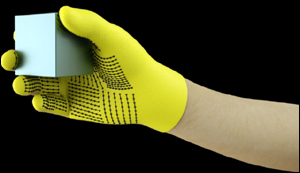Sensor-packed glove learns signatures of the human grasp
3. 6. 2019 | MIT | www.mit.edu
The researchers developed a low-cost knitted glove, called “scalable tactile glove” (STAG), equipped with about 550 tiny sensors across nearly the entire hand. Each sensor captures pressure signals as humans interact with objects in various ways. A neural network processes the signals to “learn” a dataset of pressure-signal patterns related to specific objects. Then, the system uses that dataset to classify the objects and predict their weights by feel alone, with no visual input needed.
In a paper published in Nature, the researchers describe a dataset they compiled using STAG for 26 common objects — including a soda can, scissors, tennis ball, spoon, pen, and mug. Using the dataset, the system predicted the objects’ identities with up to 76 percent accuracy. The system can also predict the correct weights of most objects within about 60 grams.

Similar sensor-based gloves used today run thousands of dollars and often contain only around 50 sensors that capture less information. Even though STAG produces very high-resolution data, it’s made from commercially available materials totaling around $10. The tactile sensing system could be used in combination with traditional computer vision and image-based datasets to give robots a more human-like understanding of interacting with objects.
Read more at MIT
Image Credit: MIT
-jk-




